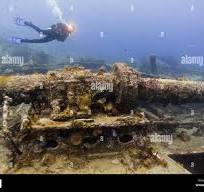RMS Rhone: Tragedy and Triumph in the Depths of the British Virgin Islands
The Wreck of the Rhone: A Maritime Tragedy in the British Virgin Islands
The British Virgin Islands, with their turquoise waters and idyllic landscapes, are a haven for sailors and adventurers alike. Among the numerous tales that weave through the history of these islands, one stands out – the tragic story of the RMS Rhone, a British steamship that met its untimely demise off the coast of Salt Island. The wreck of the Rhone has become an iconic underwater attraction and a haunting reminder of the perils faced by seafarers in the late 19th century.
The RMS Rhone was a state-of-the-art vessel in its time, a product of the Industrial Revolution and a symbol of technological progress. Launched in 1865, the Rhone was a marvel of engineering, equipped with both sails and a steam engine, making it one of the fastest and most advanced ships of its era. The ship primarily served the route between England and the Caribbean, transporting mail, passengers, and cargo.

Scuba diver exploring the Wreck of the Rhone
However, tragedy struck on the stormy morning of October 29, 1867. The Rhone, under the command of Captain Robert Wooley, was anchored in Great Harbour, Peter Island, seeking refuge from an approaching hurricane. The hurricane, later known as the San Narciso Hurricane, was a powerful Category 3 storm that battered the Caribbean with fierce winds and torrential rain.
As the storm intensified, Captain Wooley faced a difficult decision: whether to stay anchored in the relatively sheltered harbor or attempt to navigate the open sea. In a tragic twist of fate, he chose the latter, believing that the open sea offered a better chance of survival. Unfortunately, this decision proved fatal.
The Rhone battled the hurricane’s wrath, but the powerful winds and churning seas were too much for the mighty vessel. The ship was slammed into Black Rock Point off the coast of Salt Island, splitting in two. The stern sank almost immediately, while the bow, battered and broken, was swept across the bay, coming to rest in Lee Bay, where it remains today.
Of the 146 people on board, only 23 survived the disaster. The rest, including Captain Wooley, perished in the unforgiving waters. The survivors faced the additional challenges of finding shelter and sustenance on the deserted islands, as the hurricane had devastated the landscape.
The wreck of the Rhone lay undiscovered for many years, its broken pieces scattered across the ocean floor. It wasn’t until the 1950s that the site gained attention when renowned underwater explorer and filmmaker Peter Gimbel led an expedition to document the remains of the ship. The underwater footage captured by Gimbel brought the Rhone’s tragic tale to a global audience.
Today, the wreck of the Rhone is a popular dive site, attracting enthusiasts and adventurers from around the world. The site is divided into two main sections: the stern, resting in deeper waters, and the bow, lying in shallower depths. Both sections offer a haunting glimpse into the past, with the remains of the ship covered in colorful coral and inhabited by an array of marine life.
Divers can explore the intact propeller and the iconic “The Royal Mail Ship Rhone 1865” plaque on the stern. The bow, with its anchor and scattered debris, provides a captivating underwater landscape. The marine life surrounding the wreck includes nurse sharks, barracudas, and a variety of tropical fish, creating a unique and immersive diving experience.
Despite its tragic history, the wreck of the Rhone stands as a testament to the resilience of nature and the enduring spirit of exploration. The once-mighty steamship, now a silent witness to the passage of time, has become a living reef, teeming with marine biodiversity. The site serves as a poignant reminder of the delicate balance between human endeavors and the forces of nature.
In addition to its significance as a dive site, the wreck of the Rhone has inspired various works of literature and film. The story of the disaster has been retold in novels, documentaries, and even a Hollywood film, further immortalizing the ill-fated vessel and its crew.

Colorful hard and soft coral cover the Wreck of the Rhone
Preservation efforts have been undertaken to protect the fragile remains of the Rhone from the impact of human activity and climate change. The site is now a designated marine park, and regulations are in place to ensure responsible diving practices. Visitors are encouraged to appreciate the underwater beauty while respecting the historical importance of the wreckage.
As the sun sets over the British Virgin Islands, casting its warm hues across the sea, the wreck of the Rhone remains a silent guardian of the past. It serves as a poignant reminder of the unpredictable nature of the Caribbean waters and the indomitable spirit of those who venture into the unknown. The tragic tale of the RMS Rhone endures, echoing through the waves and captivating the hearts of all who are drawn to its haunting depths.
